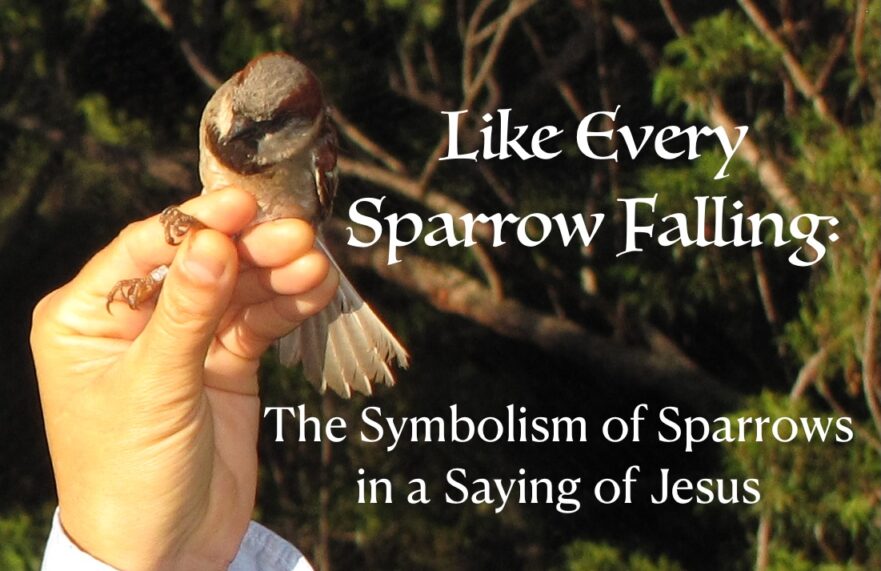How to cite this article: Joshua N. Tilton, “Like Every Sparrow Falling: The Symbolism of Sparrows in a Saying of Jesus,” Jerusalem Perspective (2025) [https://www.jerusalemperspective.com/31282/].
| Rather listen instead? |
| JP members can click the link below for an audio version of this essay.[*]
Paid Content
Premium Members and Friends of JP must be signed in to view this content. If you are not a Premium Member or Friend, please consider registering. Prices start at $5/month if paid annually, with other options for monthly and quarterly and more: Sign Up For Premium  |
To embolden his disciples in the face of persecution, Jesus assured his audience that while in the marketplace human beings may sell a group of sparrows for a few coins, not one sparrow falls to the ground without God’s knowledge and consent. Yet the mission of the disciples was of even greater interest to God than the small doings of sparrows. God may be aware of every individual sparrow that falls, but every single hair on the head of each and every disciple was numbered.[14] Since the disciples are of far more importance than sparrows, Jesus’ followers can take heart that whatever befalls, they will never be outside God’s attention or care (Matt. 10:28-31 ∥ Luke 12:4-7).[15] But of all God’s creatures to chose from, why did Jesus choose the sparrow for his admonition? And was it to a sparrow specifically that Jesus referred or just to small birds in general? We will address these questions in reverse order.
Premium Members and Friends of JP must be signed in to view this content.
If you are not a Premium Member or Friend, please consider registering. Prices start at $5/month if paid annually, with other options for monthly and quarterly and more: Sign Up For Premium

| [*] Music in the Audio JP files is excerpted from the Hebrew song Moshe written by Immanuel Zamir in a recording sung by Yaffa Yarkoni obtained from Wikimedia Commons. |
- [1] See D’Arcy Wentworth Thompson, A Glossary of Greek Birds (Oxford: Clarendon, 1895), 160 [https://archive.org/details/glossaryofgreekb00thom/page/160/mode/2up]. ↩
- [2] See Edwin Hatch and Henry A. Redpath, A Concordance to the Septuagint and the Other Greek Versions of the Old Testament (Including the Apocryphal Books) (3 vols.; Oxford: Clarendon, 1897; repr., 2 vols.; Grand Rapids: Baker, 1983), 2:1297. ↩
- [3] See F. S. Bodenheimer, Animal and Man in Bible Lands (Leiden: Brill, 1960), 56. ↩
- [4] See F. S. Bodenheimer, Animal Life in Palestine: An Introduction to the Problems of Animal Ecology and Zoogeography (Jerusalem: Mayer, 1935), 156. Cf. H. B. Tristram, The Survey of Western Palestine: The Fauna and Flora of Palestine (London: Committee of the Palestine Exploration Fund, 1884), 67 [https://archive.org/details/surveyofwesternp00tris/page/66/mode/2up]; Jehuda Feliks, The Animal World of the Bible (Tel Aviv: Sinai, 1962), 61. ↩
- [5] See Thompson, A Glossary of Greek Birds, 162; Feliks, The Animal World of the Bible, 61. ↩
- [6] Feliks, The Animal World of the Bible, 61. ↩
- [7] Cf., e.g., H. B. Tristram, The Natural History of the Bible (9th ed.; London: SPCK, 1898), 204. ↩
- [8] The Modern Hebrew name for the House Sparrow is דְּרוֹר הַבַּיִת (de·RŌR ha·BA·yit). See the Hebrew Wikipedia page: https://he.wikipedia.org/wiki/%D7%93%D7%A8%D7%95%D7%A8_%D7%94%D7%91%D7%99%D7%AA. ↩
- [9] Jesus was equally critical of Roman imperialism, taking to task “the kings of the Gentiles” who lord over their subjects while calling themselves benefactors (Luke 22:25). ↩
- [10] The Hebrew text reads: מה ציפורין חוץ מדעת עליון אינן נתפסין אף אנו חוץ מדעת עליון נתפסין. ↩
- [11] Tristram, The Survey of Western Palestine: The Fauna and Flora of Palestine, 68; Bodenheimer, Animal Life in Palestine, 158. ↩
- [12] See The International Union for Conservation of Nature (IUCN) Red List of Threatened Species report at the following link: https://www.iucnredlist.org/species/22718197/280993767 (accessed 3Oct2025). ↩
- [13] A reference to the resurrection is implicit in Jesus' saying on account of his explicit reference to Gehenna (= Gehinnom). According to Jewish tradition, Gehinnom was the place where both the body and soul of the wicked were annihilated after the resurrection and the final judgment (t. Sanh. 13:4). Cf. W. D. Davies and Dale C. Allison, Jr., A Critical and Exegetical Commentary on the Gospel According to Saint Matthew (3 vols.; ICC; Edinburgh: T&T Clark, 1988-1997), 2:207. ↩
- [14] See Michael Wolter, The Gospel According to Luke (2 vols.; trans. Wayne Coppins and Christoph Heilig; Waco, Tex.: Baylor, 2016-2017), 2:136. ↩
- [15] The differences between the Lukan and Matthean versions of the saying will not detain us here. On the whole, it is the author’s opinion that Matthew’s is the closest to the pre-synoptic version of the saying, with the possible exception of Luke’s “five sparrows for two assarions.” Cf. François Bovon, Luke: Hermeneia—A Critical and Historical Commentary on the Bible (3 vols.; trans. Donald S. Deer; Minneapolis: Fortress, 2002-2013), 2:181. ↩




